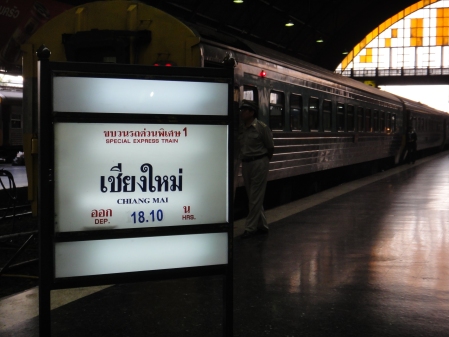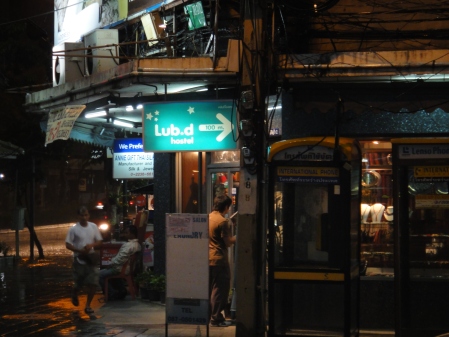My new travelling companion, who on the morning we were due to leave Chiang Mai had acquired an ominous pair of high heels outside his room which didn’t bode well for our 9am departure, slept like the buddha during the 2-day boat trip up the Mekong from Huay Xai to Luang Prabang. Slumped on a table, sprawled across some rice bags or just on the floor in everyone’s way, Markus mastered sleep as we moseyed up the river to the sleepiest town on the South East Asia tourist circuit. As my Lonely Planet says, time slows down when you come to Laos from Thailand. People walk slower, talk quieter, and even the tuk-tuk drivers can’t really be bothered. Only my remaining internet time, ticking down to zero in the bottom right corner of my screen, is in a hurry.
I met Markus on the Mr Whisky trek, which took a few days to come together thanks to the post-protest tourism drought in Thailand. We needed at least three people on board for the trek to be possible, and I was alone on the list for about three days before our ‘SpicyThai too far’ tuk-tuk lady sidetracked Markus and Thomas to Chiangmai Inn. As the three of us sat down for the trek’s evening-before briefing, Dave and Marie jumped on board. Dave, as it happens, was in the seat next to me on my flight from Heathrow a week earlier. Now he was checked into the room next to mine, courtesy of our consistently impressive tuk-tuk lady.
An Israeli girl, a vegetarian, I’ve since met was disgusted by her river boat guide in Vietnam when he scooped a snake from the waters and popped it in his full whisky bottle, where it squirmed for a while and drowned. Creepy crawlies bring great health benefits when soaked in whisky in this part of the world, and I didn’t do my budding friendship with Sapphira much justice when I explained to her that on my Chiang Mai trek we caught a tarantula and drank whisky from its carcass before cooking it on a campfire the next day and snacked on its legs.
I set my alarm for 5.30am for a 6am start to our three-day trek. We jumped in the back of a four-by-four with our monsoon-proof backpacks and ricocheted between the railings in our rickety 3-hour drive out of civilization. We stopped at a nameless place, at a small Karen village, where we had noodles and coke for lunch before being shown to a household, a musty kitchen-bedroom duplex, and introduced to their tenants. There was a wood fire burning in the kitchen and the smoke stung our eyes. We had a go on their bomboo bong, smoking a tasteless root of a tree which apparently relieves headaches. After all our daft questions about the “bong thing” our Karen host learned the useful English word bongting and was pleased enough with our company to give us the bong (easy enough to make a new one next time he’s in the forest) and some root for the road.
He accompanied us for a little while, just to the edge of the ambiguous borders of the village where he showed us how to trap animals. First a small noose trap for small mammals, then a bigger one for large rats, and finally a deadly spear trap for wild boars, or even tigers. We carried on up some steep slopes, cutting up any impeding jungle with our knives, stopping here and there to learn about plants that come in handy in various situations. This one for stomach pains, this one for fevers, this one to light camp fires, this to swing on Tarzan-style for a bit of fun. At around five, we arrived at an elephant taxi stand where we exchanged sugar cubes for rides. Just as it started pissing it down with the obligatory evening monsoon, the jungle opened up onto some paddy fields and we dragged our soggy feet to a Hmong encampment, our home for the night.
Even after two deafening cracks of the rifle, two missed shots, the animal kept its spot in the canopy, a pair of eyes gleaming like raindrops in the darkness, reflecting the light from our head torches, giving itself up. The gun traveled to Thomas for the third shot. The animal indulged him, kept looking with its signpost eyes, as he took his time steadying and aiming, then bang, bright sparks, whiff of gunpowder, scattered leaves, and finally it came tumbling down through the tree’s layers. It was like freeing a frisbee from a park tree. I rushed to the plop and found the small flying squirrel on its side, eyes three-quarters closed, breathing shallowly. It’s alive! You have to kill it! I had no idea how and the thought scared me a little but hesitating would be cruel. I grabbed the nearest weapon, a moldy branch, and smashed it over our prey. The branch shattered into smithereens, the squirrel lived on, and Markus, as if he knew what he was doing, knelt down on one knee and pressed the point of his knife vertically down into its neck. Is, our guide, was still reloading the rifle, letting the4 children play. When she finally strolled over to inspect the prize, she seemed pretty unmoved. Not a lot of meat on this one. She picked it up like a toy, spread its wings, and revealed a tiny, hardly bloody wound in its chest . The gun was loaded with a cluster of small pellets that sprays out towards the target when the trigger’s pulled. All it takes is for one of those to hit a minor animal like this to send it falling.





